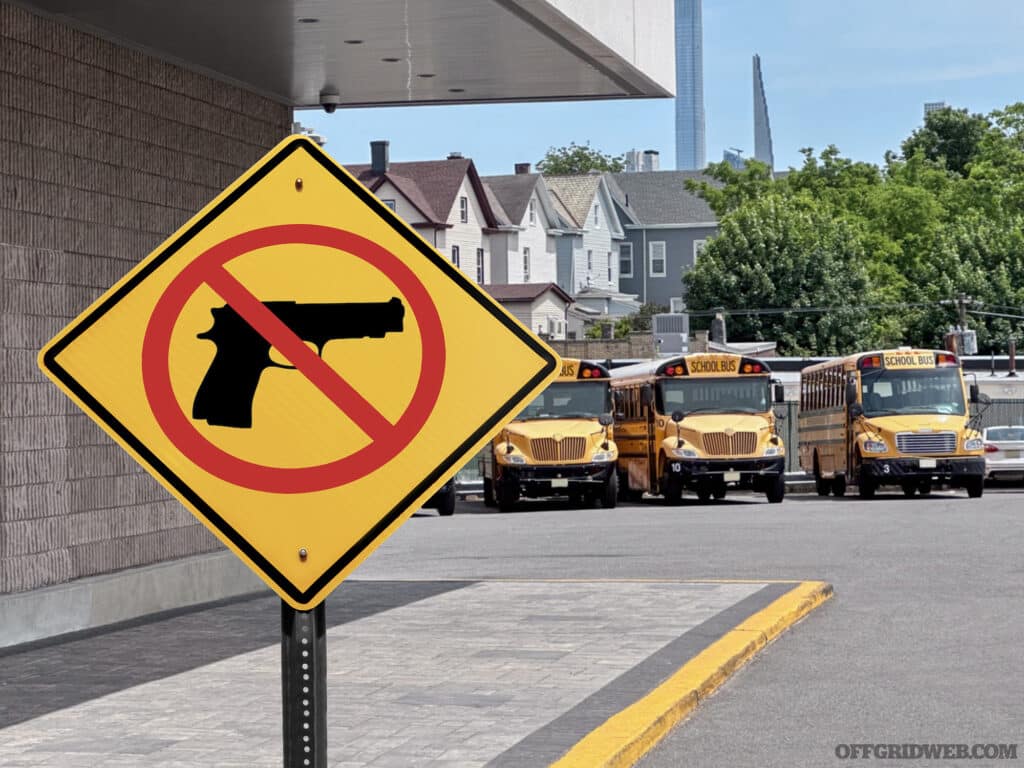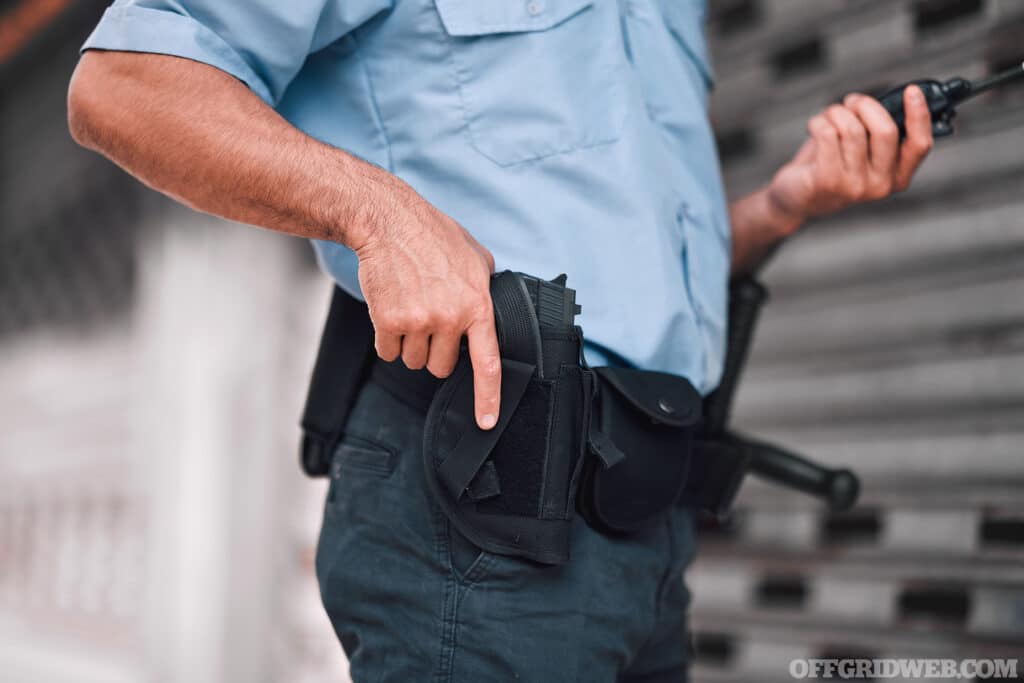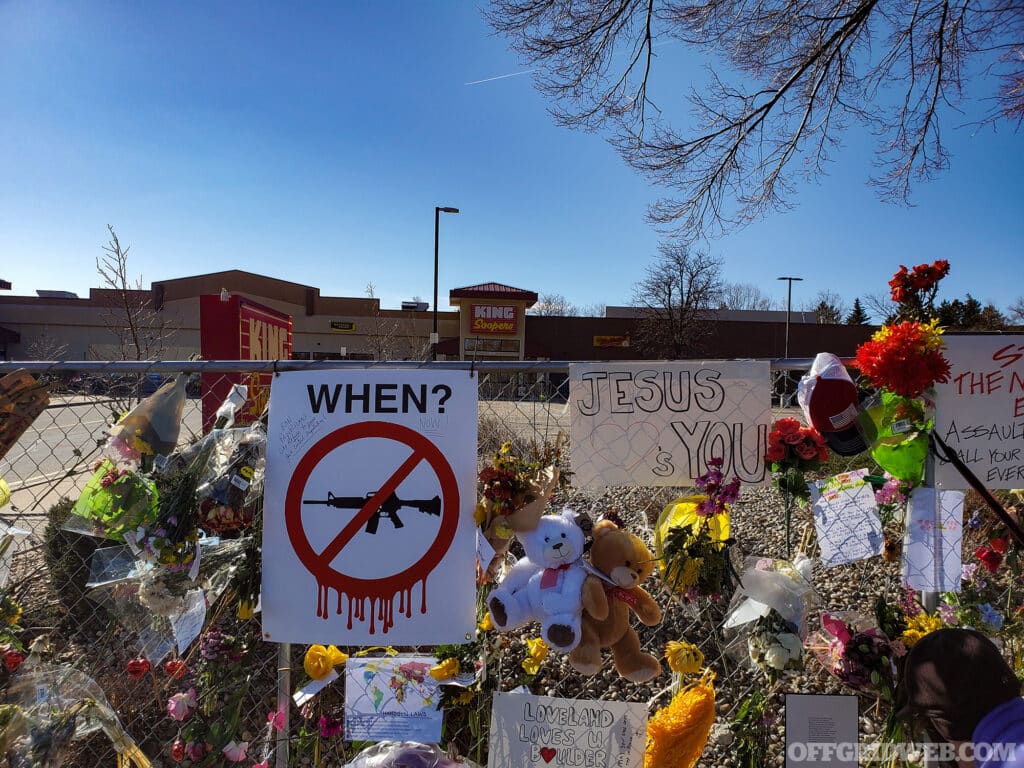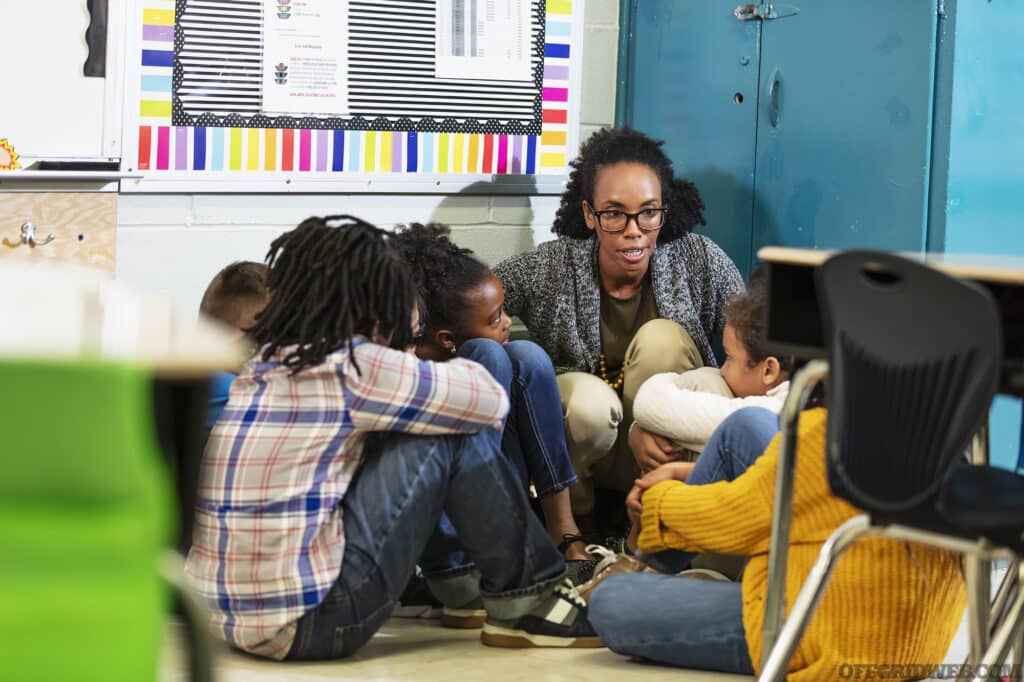School shootings are not only extremely tragic events, but they also spawn vivid discussions amongst our communities. Media pundits and politicians debate the causes of and solutions to the problem ad nauseam, but one group that we often don’t hear from are those who stand guard on the front lines of defense every day: teachers. The teacher is the eyes and ears of our school system, so it goes to say that they have a stronger finger on the pulse of students than most. Their voices, however, are often drowned out regarding the struggles, anxieties, and stories that today’s educators share on the frontlines of the classroom.

Above: Posting signs is only the start. Teachers and the community must be involved (Photo credit: iStock – gerenme).
Painting the Picture
Before we can see through the eyes of the teacher, we need to gain a proper perspective of what characterizes an active shooter incident in our schools. An active shooter event is commonly defined as an individual actively engaged in killing or attempting to kill people in a confined and populated area. Most active shooter attacks last anywhere from 5-7 minutes, with some reports lasting up to 15 minutes.
In many cases, the attack is already over by the time law enforcement arrives. Adam Blanton, the Assistant Chief of Police for Richmond, Indiana, believes that the overall approach to active shooters from a law enforcement perspective has changed. “One of the first things we have adopted from our standpoint, especially using the Columbine High School incident as a baseline, is that the established protocol today is that you go in. The first officers on the scene are going in and they are going toward the sound of gunfire.
According to the Center for Homeland Defense and Security, most active shooting events happen on Fridays, typically in the early morning hours as school is starting. However, there is not enough evidence to note this as a conclusive pattern in school shooting events. The Federal Bureau of Investigation (FBI) determined in their own study that an overwhelming number of attackers were current students within their own school system and displayed 4 to 5 very telling behaviors prior to the attack.

Above: Problematic signs can be difficult to detect. However, sometimes they are not so subtle (Photo credit: iStock – DEBBY LOWE).
These behaviors included problematic interpersonal interactions and signs of violent intent, both of which can indicate a potential future attack. Rick Wilcox, a Student Resource Officer for the Nettle Creek School Corporation in Indiana thinks that “we’re doing better, but more still can be done for mental health and how it relates to school shootings. Even with increases in federal funding to examine the role of mental health, it really is just the tip of the iceberg in terms of what can be done to mitigate school shootings on a National level.
A Troubled Teen Profile
While not definitive, the following are Personality Traits and Behaviors sometimes exhibited by troubled students who might be considering school-based violence at some level:
- Low Tolerance or Frustration
- Poor Coping Skills
- Lack of Resiliency
- Failed Love Relationship
- Signs of Depression
- Narcissism
- Alienation
- Dehumanizes Others
- Lack of Empathy
- Exaggerated Sense of Entitlement
- Attitude of Superiority
- Exaggerated or Pathological Need for Attention
- Masks Low Self-esteem
- Anger Management Problems
- Intolerance
- Inappropriate Humor
- Seeks to Manipulate Others
- Lack of Trust
- Closed Social Group
- Change of Behavior
- Rigid and Opinionated
- Unusual Interest in Sensational Violence
- Fascination with Violence-Filled Entertainment
- Negative Role Models
- Behavior Appears Relevant to Carrying Out a Threat
The Role of Schools
In America, many schools are underfunded and more recently, understaffed. While rewarding, teaching is difficult work and becoming more difficult with each generation. Student enrollment in undergraduate bachelor’s programs is dwindling by the year resulting in a national shortage of college-educated teachers. This not only makes it difficult for school administrations to fill empty roles with recent graduates but lowers the morale of overworked educators who are trying to understand the cultural shift in today’s student.
While school shootings are major events that shock our nation, there are still many in our communities who believe that it couldn’t happen in their school system. “Normalcy bias” is a cognitive bias that leads people to underestimate the possibility of disaster and underestimate the negative or harmful effects of a disaster as it’s happening. Former member of the CIA and best-selling author Steve Tarani states that normalcy bias encompasses a state of mind we enter when faced with a threat that overwhelms our mental capacities. “It makes you disbelieve your situation when faced with grave and imminent danger,” and causes you to “greatly under-estimate the severity and most likely consequences.
In turn, it causes you to reinterpret the event, rather than taking evasive or decisive action.” Unfortunately, many community leaders subconsciously believe that they are immune to active shooters and may not fully support the measures needed to optimally protect the children entrusted in their care. “These things happen sporadically in areas that you would never think. People tend to believe that a school shooting is beyond their community, or they don’t have a cultural problem like gang activity to deal with, so they’re not prone to such issues. I think that sort of violence is so far out of place for those communities,” says Blanton. Although disasters elsewhere may well be on the radar, their minds tell them that it will never happen to them, and their preparation (or lack thereof) soon follows.

Above: Many schools have adapted to active shooter threats by having Law Enforcement present during the school day (Photo credit: iStock – Jacob Wackerhausen).
Pat Tudor, a Detective for the Richmond Police Department believes that schools can do more to prepare themselves for active shooter situations. “There are a lot of discussions, but not a lot of implementation. Not a lot of school administrators or community leaders say that they’re actually going to make something happen and stick to it.” School Crisis Plans are typically accompanied with School Safety Specialists who help develop, monitor, and train others within schools on how to deal with hazards and threats ranging from the standard monthly fire drill to re-unification plans after a disaster has occurred. While many school employees and faculty members are uneasy about addressing school shootings, it is a possible threat that many must stare down, overcoming their trepidation to deal with the threat head on.
To do just that, school administrators, along with School Safety Specialists, perform threat assessments on an as-needed basis. A threat assessment could run the spectrum from evaluating unlocked doors all the way to evaluating a troubled student with consistent or erratic disciplinary issues. Threat assessments are an important part of dialing in on the safety pulse of a school and can lend themselves to actionable steps the school can take upon themselves to further safety measures for the student body. Of course, communication is key. Keeping fellow teachers and administrators in the loop as it relates to safety and emotional health issues is a vital component to addressing specific problems before they become a flood of calamity.
In 2015, the Sandy Hook Advisory Commission created a report that included recommendations on how to improve school safety and lockdown procedures. Many of these procedures are in place today amongst school districts and include the ability to lock classroom doors from the inside if a threat becomes active. While other technical recommendations were suggested, one that envelops the push for safer schools is increased safety and security training for all faculty, staff, and students. This becomes the cornerstone of active shooter preparedness, but many schools find themselves under-prepared followed by a lack of adequate funding to mitigate potential problems.
These barriers open the possibility of bringing student involvement to the table as an option. The fact is adults know the most on how to keep students safe. Students, however, can run circles around faculty when it comes to knowledge of their peers. Students will know who is up to what, who is smoking what, and who is dating who. They know more than we ever will about the pulse of their fellow students within school walls. What they lack, though, is the knowledge to properly evaluate their surroundings and put the dots together. In other words, they have the knowledge but lack the instinct that is learned over time by adults. It makes sense to combine both the knowledge of students and the intellects of their adult teachers to bring about a fresh perspective to active shooter policy.

Above: School shootings are tragic on a community level, affecting everyone with ties to the school (Photo credit – iStock: raclro).
Students should be involved in some level of decision making because they are more aware of social dynamics and can intervene in ways that adults cannot. Social media posts are an example of how students can monitor the activities of their peers and have been proven to be extremely useful in circumventing potential active shooter incidents. Encouraging students to become peacemakers will improve a student’s emotional intelligence, communication skills, and overall climate of a school. This gives the student ownership of their safety, rather than depending only on adults to provide it for them. This also serves students of all ages to grow and become more responsible for their small microcosm of society, which is one of the missions to educate our youth in the first place.
Students should also have some input on the drills that schools practice. For many in emergency management, the level of training in school corporations fails to meet the mark of current threats in America. Granted, “duck and cover” during the Cold War era was a ridiculous practice in preparation for a nuclear attack. But when was the last time we’ve heard of a school burning down? Yet schools are required by their states to practice fire drills once a month.
Fire drills have their place and can be utilized to practice for any sort of evacuation, but the fact that there is often no requirement for active shooter lockdown drills seems every bit as ludicrous as “duck and cover.” Additionally, requiring off-site evacuation and reunification drills during school hours is like “pulling teeth for school corporations, but they are as every bit important as an active shooter drill since they will inevitably follow an active shooter event,” according to Pat Tudor.
Enter the Classroom Teacher
To be fair, dealing with school violence is not something any teacher dove into the profession of education for. They’re just not trained to deal head on with situations that potentially put their lives at risk. Teachers are some of the most overworked, underpaid positions in America. So, putting any kind of expectation on them to be frontline security guards — on top of all their other duties — is unrealistic. But these are different times we live in.
It shouldn’t be their problem, but if we are to take a community approach to school shootings, then they are at least part of the solution. So how should teachers approach classroom preparedness when it comes to preparing themselves and their students for the possibility of active shooter incidents? The following are seven practices that teachers either have or could incorporate into their daily regimen to help prepare their students for anticipating the unthinkable active shooter event:
Practice #1
Understand their responsibility and influence over their students
This practice might go without saying, as any good teacher will always know the depths of how they influence students, but it’s worth mentioning anyway. After interviewing several students, one suggestion resurfaced several times, which is teacher-student interaction. While it’s true that students know their peers better than anyone else, it is the teacher who can put that information into proper perspective.
Teachers begin to see behavior patterns in their classrooms and eventually begin to deduce that things outside of the classroom may be interfering with education efforts such as relationship problems, bullying, problems at home, or even when some students are under the influence of drugs or alcohol. The teacher is the first line of defense when it comes to being “situationally aware” of student personalities and their learning environment. As teachers establish expectations and mentor struggling students, they can become more aware when things are out of sorts.

Above: Overt behaviors are a clear indicator that a student may be struggling (Photo credit: iStock – P_Wei).
Practice #2
Maintain a safe, inviting, interactive classroom
Classrooms should be safe environments, especially when it comes to Junior High/Highschool age brackets. A teenager’s hormone levels ride volatile waves like a rowboat in a hurricane and their reactions are more apt to spike and drop at a moment’s notice. The calmer the learning environment, the more at ease the student will be. Classroom interactivity also plays an important role in the lives of today’s students. With each passing generation, old ways of teaching must be laid to rest. If today’s students attempted to learn from an overhead transparency projector, teachers would be guaranteed to have a scholastic mutiny on their hands within ten minutes. Time to switch it up.
Practice #3
Maintain an offensively defensive classroom
Say what? It sounds confusing, especially as it relates to a classroom. Classrooms, first and foremost, must provide safety for students as well as the teacher. Developing a classroom to be both defensive and offensive is a practiced action. Positioning large furniture to be moved to barricade a door is an example of taking the offense in room protection from outside threats. Some teachers actually collect soup cans or rocks to hand out to students to be utilized as offensive weapons in the case a school shooter enters the premise.
These items can also double as food drive supplies or the next lesson in geography. Be creative. The phrase “the best defense is a proper offense” is also known as the strategic offensive principle of war. Generally, the idea is that proactivity (a strong offensive action) instead of a passive attitude will preoccupy the opposition and ultimately hinder its ability to mount an opposing counterattack, leading to a strategic advantage. When the student’s life is on the line, passivity should be thrown out the window and teachers should emotionally equip students to take the offensive as a last resort for their survival.

Above: Teachers have the strongest influence regarding how well a classroom can be defended, and how smooth a lockdown drill goes (Photo credit: iStock – kali9).
Practice #4
Be on board with school safety policies
As the saying goes, a chain is only as strong as its weakest link, and the same is true of security protocols. So, it’s important that everyone follows the same school safety policy. If the plan is solid, then any deviation of the plan from any one faculty member weakens the plan and potentially puts others in danger. This is not to say that people shouldn’t think for themselves, but not at the expense of a solid plan aimed at saving lives. Being on board with school safety policies means that teachers need to be willing to train the plan until they feel confident in their ability to save their life and the lives of their students.
Practice #6
Talk honestly and openly with students about school shootings
Obviously, this is an age-appropriate rule that can have both positive and negative ramifications if not handled with care, but the conversations need to happen. Teachers should approach young children with brief and simple information that should be balanced with reassurance. Upper elementary and early middle school children may be more vocal in asking questions so it might be a good idea to discuss what is being done at the school to help ensure their safety.
Upper middle school and high school students may have strong and varying opinions about causes of violence in school and society. Teachers should stress the role that students have in maintaining safe schools by following the school's safety guidelines. It's also best, regardless of age, not to provide false reassurance or minimize their distress. We need our students to be vigilant, but not anxious about potential threats. It’s much better to help children learn to cope with distressing feelings, rather than pretend they don't or shouldn't exist.

Above: Students cope with stress in various ways. It's important to approach these issues on and individual level (Photo credit: iStock -bodnarchuk).
Practice #7
Drill down how students react to an active shooter event
On top of the regular emergency drills, teachers must train for active shooter preparedness and should be the first to understand these emergency responses so they can guide their students through the drills. When it comes to equipping students with knowledge of how to handle active shooters, there are two main schools of thought: ALICE and Run-Hide-Fight. ALICE training stands for Alert – Lockdown – Inform – Counter – Evacuate.
The other training is known as “Run-Hide-Fight,” developed by the F.B.I. Both programs are viable active shooter response training, but knowing which one is for you really depends on your preference. “Run-Hide-Fight” has a slight majority of proponents because of its simplicity. Also, it equips its practitioners with more individual involvement in threat response than ALICE does. “Run-Hide-Fight” allows students to run out of the school if the opportunity presents itself, and if not, fight for their lives by any means necessary.

Above: Regular training is an important measure to mitigate an active shooter situation (Photo credit: iStock – Brycia James).
Both are excellent programs. The idea is to provide basic, easy-to-remember actions in the event that people find themselves in an active shooter incident. Pat Tudor believes that programs such as ALICE are instrumental for school safety. “Schools should really send members of their safety committees to ALICE training or like-minded programs so they can train other staff members, especially with the high turnover rate amongst teachers and students.”
Another common concept from both the training programs is the importance of going into lockdown. Both ALICE and Run-Hide-Fight emphasize that if evacuation is not feasible at the time of the attack, it’s better to get into a room and stop the shooter from entering it. In schools, teachers should mobilize students to lock classroom doors from the inside. Aside from locking classroom doors, these also need to be barricaded to prevent any intruder from forcing their way inside.
When a school conducts practice drills, teachers must provide an overview to students. Doing so will ensure that students do not have unnecessary anxiety towards the drills. “Educators need to realize that they no longer have a choice in the matter. We have to be open about it, train ourselves and train our students until it becomes second nature,” says Rick Wilcox.
What is Active Shooter Leakage?
“Leakage” occurs when a student intentionally or unintentionally reveals clues to feelings, thoughts, fantasies, attitudes, or intentions that may signal an impending violent act. These clues can take the form of subtle threats, boasts, innuendos, predictions, or ultimatums. They may be spoken or conveyed in stories, diary entries, essays, poems, letters, songs, drawings, doodles, tattoos, or videos.
Another form of leakage involves efforts to get unwitting friends or classmates to help with preparations for a violent act, at times through deception (for example, the student asks a friend to obtain ammunition for him because he is going hunting). Leakage can be a cry for help, a sign of inner conflict, or boasts that may look empty but actually express a serious threat. Leakage is considered to be one of the most important clues that may precede an adolescent's violent act.
Moving Forward
Society is just different than it used to be, and there’s not one direct reason why these circumstances are at our community doorsteps. “We have to acknowledge that we can’t put the toothpaste back in the tube. We have an entire generation who was raised by social media who just have a different view of the world,” says Tudor. Teachers are tasked to ensure all students are aware of what to do in times of crisis. They are the ones that will make sure that students understand what needs to be done and why this is happening. It all comes at a cost, according to Adam Blanton. “We don’t have to let people keep hurting each other. It’s going to require us having a serious conversation and being steadfast to see a change in our culture so this stops becoming the problem that it is.”

Above: Today's students are growing up in tumultuous times, and the adults in their lives must help guide them through today's unique challenges (Photo credit: iStock – Constantinis).
The innocence of our children is quickly being lost to a culture steeped in emotional discord, and the end result is concerning. It’s the responsibility of every adult to protect our children from violence, but this challenge is most relevant to teachers on the front lines. They are the ones who change lives every day and now stand as shields for our children. The rest of us must do our best to encourage, empower, and train those who spend years shepherding the most vulnerable members of our society.
About the Author
Mark Linderman
MSM, CEM, CSSS, CCPH
Mark Linderman is the owner of Disaster Initiatives, an online company that provides communication leaders with the tools needed to address their communities and the media throughout a crisis, teaching the communicator to approach crisis communication from the listener’s perspective. He is a Certified Emergency Manager (CEM) and nineteen-year veteran of Public Health. He instructs Crisis & Risk Communication and Disaster Preparedness courses for seven universities, including Indiana University’s Fairbanks School of Public Health. Mark is considered a Subject Matter Expert in the field of disaster-based communication and is a widely received public speaker and advocate for disaster preparedness. He can also be found on LinkedIn.
Read More
Don’t miss essential survival insights—sign up for Recoil Offgrid's free newsletter today!
Check out our other publications on the web: Recoil | Gun Digest | Blade | RecoilTV | RECOILtv (YouTube)
Editor's Note: This article has been modified from its original version for the web.
The post Lockdown: Preparedness Measures for School Shootings appeared first on RECOIL OFFGRID.
By: Patrick Diedrich
Title: Lockdown: Preparedness Measures for School Shootings
Sourced From: www.offgridweb.com/preparation/lockdown-preparedness-measures-for-school-shootings/
Published Date: Fri, 20 Sep 2024 18:56:17 +0000
------------------------
Did you miss our previous article...
https://bushcrafttips.com/bushcraft-news/how-to-build-a-survival-stockpile-with-coupons
 What is BushcraftSurvival SkillsToolsVideosBushcraft CampsBushcraft KitsBushcraft ProjectsPrivacy PolicyTerms And Conditions
What is BushcraftSurvival SkillsToolsVideosBushcraft CampsBushcraft KitsBushcraft ProjectsPrivacy PolicyTerms And Conditions
